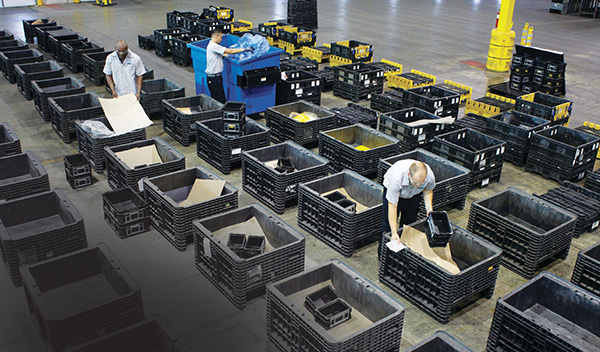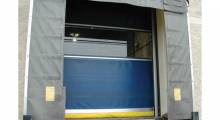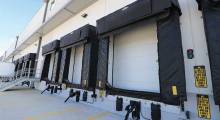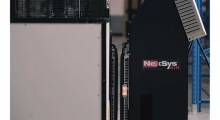A March upturn was the second gain of the year, a substantial improvement when compared to 2017’s sales figures, according to Autoweek. When you consider the continuous change in automation, equipment and technology, as well as the positive impact of new products aimed at employee productivity, the future is bright.
To continue this surge in throughput, automotive plants are using workstations, bulk containers, creeping towline conveyors and track-and-trace systems. Here’s a look at the trends and advances in each of these areas.
Workstations
Due to the potential for multiple shifts and job sharing within automotive facilities—along with relatively high turnover—plants are now seeking workstations with adjustability features. Suppliers like Creform now provide up to 12 inches of height adjustability in their electric and manual ergonomic tables.
“Such adjustability will accommodate a wide range of people,” says Keith Soderlund, vice president of sales for Creform. “Workers like having control and comfort, which results in productivity, quality and even retention.”
At the same time, suppliers are integrating LED lights directly into their workstations. Not only are they economical (as their prices continue to decline), but they don’t require maintenance and offer considerable lighting given their small size.
To prevent assembly mistakes and train new employees, some automotive facilities are even purchasing more pick-to-light systems for their workstations.
“A mispick found down the assembly line can be very costly to remedy,” Soderlund explains. “But with pick-to-light systems’ projection lights—some of the newest technology offered with the systems—employees can receive guidance during the assembly process, as the lights shine directly on the work surface, along with the parts that need to be picked.”
Another feature companies are looking for is workstations with wheels. These workstations not only make them much easier to reposition as employees’ needs change throughout the assembly process, but they also improve the plants, as spaces underneath workstations can be easily be vacuumed or mopped. It’s vital for the wheels to have reliable locks, though, for when stability is needed.
Many operations are also integrating at least one screen (often more than one) into the workstations to control documentation. Electronics were once very expensive to integrate into workstations, but the costs are starting to decline.
“There’s no longer a need to trace down paper when there’s a change,” Soderlund adds. “And work areas are much cleaner now, as there’s less of a need for clipboards, loose documentation and notebooks.”
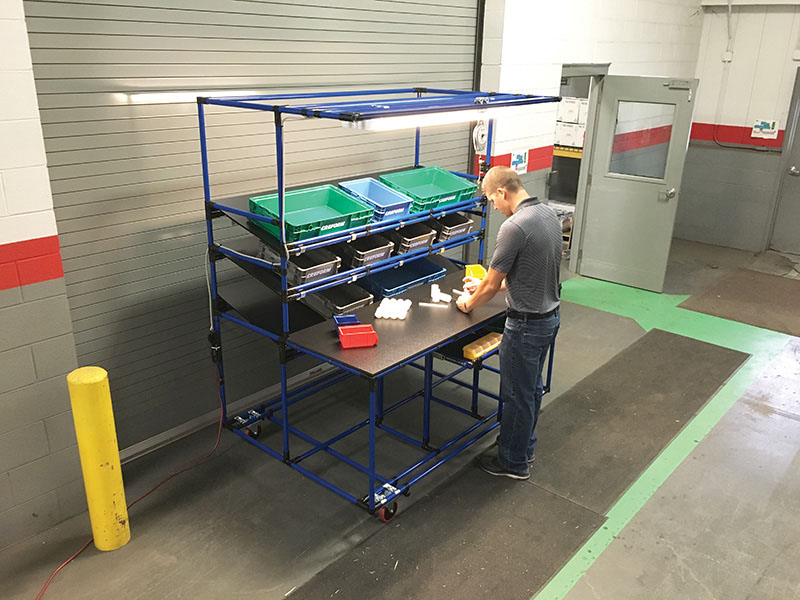
Bulk containers
The demand for more customized options on automobiles is requiring OEMs to produce a wider variety of vehicle options. As a result, SKUs are rising exponentially to meet this demand. In addition, new trucking regulations require most commercial truck drivers to use electronic logging devices—leading to a decline in road time and driver availability.
Transportation costs are rising, as more freight is now being used to move parts from tier suppliers to OEMs. To address these issues, automotive manufacturers are purchasing packaging that can fit more parts in each container.
“Bulk containers are a useful packaging option because they can transport large quantities and better protect products during picking, assembly, processing, storage and distribution,” says Scott Krebs, industrial marketing manager at ORBIS Corp.
One container, the ORBIS’s HDMP4845, allows 28 total positions (two more than standard 48 x 45-inch containers) for every 53-foot truck, while also maintaining the internal capacity of typical 48 x 45-inch bulk containers. This allows trucks to transport more materials in each bin, as well as fit more bins in their trucks, resulting in fewer needed trips.
The all-plastic design of the reusable containers offers drivers more dimensional consistency, improved handling, less rust and part damage and more reliability, as containers are stacked when compared to metal packaging.
“Reusable bulk containers’ two-piece, spring-loaded latches also enable them to collapse for more efficient return truckloads and allow open-and-close access doors,” Krebs adds. “Consequently, an inbound truckload can carry 84 filled HDMP4845 containers, while a return truckload can transport 252 collapsed HDMP4845 containers—44 more than it could transport with standard 48 x 45-inch bins.”
Towline conveyors
In the past, the combination of quality and increased production was viewed as counterintuitive for assembly operations in the automotive industry. But that’s no longer the case, as towline conveyors offer a more cost-effective alternative to other systems, especially for the movement of parts between assembly stations. Not only can these conveyors be installed for a relatively low price, but they can provide operators a long-term conveyance solution—one that offers increased uptime and requires very little maintenance.
“Essentially, towline systems are a means of conveying assemblies from one workstation to the next in a predictable sequence,” says Jim English, applications engineer for SI Systems. “However, towline systems also lend themselves easily to interface with solutions that improve the overall productivity of warehouses and distributions centers—including loading, unloading and automated electronic cart weighing.”
Towline conveyors are offered in two assembly configurations: index and dwell, which is a configuration that allows operators to assemble parts as they remain completely motionless in their workstations; and creeping, a configuration that moves at a very slow speed, resulting in the elimination of lost indexing time, as operators can work on assemblies as they “creep” through their workstations.
“Since this slow speed precisely matches the assembly time, the creeping towline conveyors actually pace the assembly process, thus replacing the operator-paced line that hinders throughput,” English says. “Therefore, operators gain more time to work on their assemblies, resulting in a significant increase in production off the assembly line.”
The creeping towline conveyors also feature control technology—known as No Fault Forward—which prohibits all non-conforming parts from moving to the next step of the assembly process. In doing so, the quality of automotive parts improves considerably, and the likelihood of rework declines substantially, saving money in the long run.
“These systems are not only durable, as they can last anywhere from 20 to 40 years; they also increase productivity and minimize rework,” English adds. “This focus on quality and productivity is key—after all, production throughput is the No. 1 requirement of all automotive assembly lines.”
Track-and-trace systems
The grey market is a reality, where genuine products are replaced by fake products that are created by outsourced manufacturers within the supply chain. As a result, customers—both the senders and the receivers of goods—can’t guarantee whether or not the products they’re delivering and acquiring are authentic.
To help solve this problem, Honeywell is developing a track-and-trace system that increases shippers’ and receivers’ confidence as their goods are transported throughout the supply chain. Unlike other sectors, such as pharmaceutical or tobacco, which implement trace-and-trace systems to comply with legislation, the automotive industry is not driven by regulatory needs. Rather, it’s focused on the cost of track-and-trace offerings, as they have traditionally been expensive.
“We’re seeing more and more automotive companies looking into track-and-trace as a solution for a variety of needs—including product authentication and analysis of the supply chain,” explains Mario Mira, track-and-trace product manager at Honeywell. “This is primarily occurring due to the reduction in Cloud-based solutions’ costs, the adoption of such services by companies and the advancement in technology that enables Cloud solutions providers to process the huge amount of data that track and trace generates.”
By partnering with TecAlliance, a pioneer in the product authentication industry, mainly for the automotive market, Honeywell co-developed a solution for the recent rising popularity of track and trace: oneIDentity+.
Rather than having to download a variety of apps to perform product authentication, operators can now use oneIDentity+ (on their phones) to query the authenticity of the products they have—either prior to or after distribution.
Built on the Honeywell Movilizer Cloud platform, which complies with regulatory mandates, oneIDentity+ generates a unique code for every product created by manufacturers, which can be applied to each product and uploaded into the oneIDentity+, a Cloud, software as a service that’s accessible with an app, as well as through application programming interfaces (APIs).
“It is the duty of manufacturers to make appropriate changes in their production processes though, so that these unique codes, generated with a random algorithm, can be applied to the products they produce,” Mira adds. “In doing so, these codes can then be uploaded into the platform so that its product authentication feature can be implemented successfully—and the grey market can no longer pose the threats it once presented to shippers and receivers.”
Companies mentioned in this article
Creform
Honeywell
ORBIS Corp.
SI Systems
Article topics
